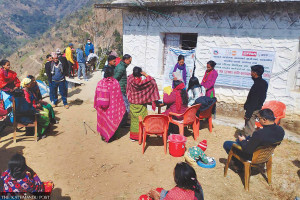 16.12°C Kathmandu
16.12°C KathmanduEntertainment
Striking the right chords
Singer Mahesh Kafle discusses how he blends traditional melodies with a modern flair in his releases.
Anish Ghimire
Mahesh Kafle fondly recalls listening to various songs on the radio growing up. One song he remembers constantly hearing on Radio Nepal is his father’s (Bhoj Raj Kafle) hit track, ‘Bottle Ko Pani Le’. This early exposure sparked his interest in music.
After completing fifth grade, Kafle, who was born in 1996 in Sindhuli, relocated to Kathmandu. Influenced by his brother’s singing, he developed a keen interest in vocal artistry. In 2008, at the age of eleven, he expressed his passion for singing to his parents. Soon afterwards, he took a voice test at Radio Nepal, which was a prerequisite for on-air performances back then. Surprisingly, he passed on his first attempt. “My father indulged my childhood whim, thinking my interests would change with age,” he shares.
Then, around the same time, Kafle got an opportunity to sing his first song, titled ‘Sautini Aama’, which gained popularity through cassettes and radio broadcasts. The accompanying video significantly boosted his recognition. “It helped that I sang about social issues,” adds Kafle.
As he entered his teenage years, his childlike voice gradually transformed into a more mature, adult tone. Kafle felt a newfound sense of freedom, prompting him to explore different paths. Initially dedicated solely to music, the change in his voice tone led him to consider other opportunities—just in case music doesn’t work out for him. He then began focusing on his academics.
Upon completing his Plus 2 in management, Kafle decided to try his hand at various pursuits. He applied for a government job and even submitted an application to join the army as a second lieutenant. “I only filled out forms but didn't go for exams because, by the time I applied, I knew passing the test was unlikely,” he confesses.
Around 2014, amid uncertainties about his future, Image Channel introduced a reality show focused on video journalism. While he didn’t progress past the initial rounds, Kafle received a surprising offer later—to work as a sports reporter.
He joined as a reporter and hosted the weekly show ‘Khel’. Over time, he also took on roles in entertainment shows. “As I was inclined towards entertainment, I handled several entertainment programmes at Image," Kafle explained.
Things went smoothly until a conversation with peers prompted him to reconsider. When his colleagues asked why he doesn’t sing anymore, Kafle began questioning whether he really wanted to give up on his childhood passion.
He began thinking about quitting his job to pursue music again, but he didn’t necessarily want to leave a stable job for the uncertainties becoming an artist would bring. Eventually, after much contemplation, he left the job. However, the abrupt shift left him feeling weary. “In an attempt to escape that emptiness, I returned when they called me back,” he admits. But he was really unhappy working as a journalist now. So, six months later, he quit again, determined to kickstart his music career.
“Even though I loved the job very much, my passion for music was just too big, so I took the step to pursue the latter,” he admitted.

While he was in the transition phase, he was writing a song titled ‘Nacha Firiri’, not anticipating that it would be a smash hit. “After I wrote the song, my friend Akash Khadka, who has always motivated me to pursue music, took my song to G21 Digital Production Company to launch it,” he explains. G21 Digital is involved in the production of Nepali movies, TV commercials and music videos.
Fortunately, on the day when the discussions of his song were going on, director Nischal Basnet and actress Swastima Khadka, were also at the G21 office. They agreed to feature in the music video and Kafle hoped its release would bring him enough name recognition to keep pursuing music forever. The video was released in 2018 and currently boasts 85 million views on YouTube.
Subsequently, two more hits, ‘Maya Birani’ and ‘Lajjawati Jhar’, came in, in intervals of one year each. The former has 95 million views, and the latter has 33 million views on YouTube. In 2021, ‘Maya Birani 2’ was released, accumulating 70 million views as of now.
Though rooted in the lok genre, Kafle’s songs carry a distinct style. “My songs are lok based as I grew up listening to lok songs, but in presentation, they aren’t strictly lok,” he explains, adding that he blends different genres—mainly, pop—and puts out more lok-pop or adunik songs.
Much like his father had a way of telling a story through lyrics and creating a narrative through music, Kafle exhibits a similar approach. He emulates the way people speak in his lyrics which makes them more lively. He clarifies that while he didn’t consciously imitate his father, the influence naturally seeped in as he grew up listening to his songs.
In total, including his childhood compositions, Kafle has sung around sixteen to seventeen songs. “I’m still learning and attempting to introduce new elements into my music. The continuous love and support from people motivate me to improve every day,” he says.
















